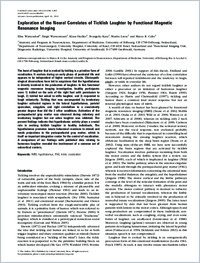Exploration of the neural correlates of ticklish laughter by functional magnetic resonance imaging
- Wattendorf, Elise Anatomy and Program in Neuroscience, Department of Medicine, University of Fribourg, Switzerland
- Westermann, Birgit Department of Neurosurgery, University Hospital, University of Basel, Switzerland
- Fiedler, Klaus Anatomy and Program in Neuroscience, Department of Medicine, University of Fribourg, Switzerland
- Kaza, Evangelia Functional Imaging Unit, Diagnostic Radiology, University Hospital, University of Greifswald, Germany
- Lotze, Martin Functional Imaging Unit, Diagnostic Radiology, University Hospital, University of Greifswald, Germany
- Celio, Marco R. Anatomy and Program in Neuroscience, Department of Medicine, University of Fribourg, Switzerland
-
16.04.2012
Published in:
- Cerebral Cortex. - 2013, vol. 23, no. 6, p. 1280-1289
English
The burst of laughter that is evoked by tickling is a primitive form of vocalization. It evolves during an early phase of postnatal life and appears to be independent of higher cortical circuits. Clinicopathological observations have led to suspicions that the hypothalamus is directly involved in the production of laughter. In this functional magnetic resonance imaging investigation, healthy participants were 1) tickled on the sole of the right foot with permission to laugh, 2) tickled but asked to stifle laughter, and 3) requested to laugh voluntarily. Tickling that was accompanied by involuntary laughter activated regions in the lateral hypothalamus, parietal operculum, amygdala, and right cerebellum to a consistently greater degree than did the 2 other conditions. Activation of the periaqueductal gray matter was observed during voluntary and involuntary laughter but not when laughter was inhibited. The present findings indicate that hypothalamic activity plays a crucial role in evoking ticklish laughter in healthy individuals. The hypothalamus promotes innate behavioral reactions to stimuli and sends projections to the periaqueductal gray matter, which is itself an important integrative center for the control of vocalization. A comparison of our findings with published data relating to humorous laughter revealed the involvement of a common set of subcortical centers.
- Faculty
- Faculté des sciences et de médecine
- Department
- Département de Médecine
- Language
-
- English
- Classification
- Biological sciences
- License
-
License undefined
- Identifiers
-
- RERO DOC 28977
- DOI 10.1093/cercor/bhs094
- Persistent URL
- https://folia.unifr.ch/unifr/documents/302309
Statistics
Document views: 364
File downloads:
- Document: 258
